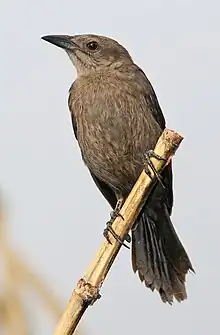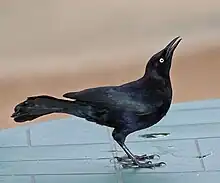Carib grackle
The Carib grackle (Quiscalus lugubris) is a New World tropical blackbird, a resident breeder in the Lesser Antilles and northern South America east of the Andes, from Colombia east to Venezuela and northeastern Brazil. There are eight subspecies, of which the most widespread is the nominate subspecies (Q. l. lugubris) of Trinidad and the South American mainland. This subspecies was introduced to Tobago in 1905 and is now common there.
| Carib grackle | |
|---|---|
 | |
| Immature Carib grackle | |
| Scientific classification | |
| Domain: | Eukaryota |
| Kingdom: | Animalia |
| Phylum: | Chordata |
| Clade: | Dinosauria |
| Class: | Aves |
| Order: | Passeriformes |
| Family: | Icteridae |
| Genus: | Quiscalus |
| Species: | Q. lugubris |
| Binomial name | |
| Quiscalus lugubris Swainson, 1838 | |
 | |
Description
The adult male Carib grackle is 27 cm (11 in) long with a long wedge-shaped tail, although the latter is not so long as other grackles. Its plumage is entirely black with a violet iridescence, its eyes are yellow, and it has a strong dark bill. The adult female is 23 cm (9.1 in) long, with a shorter tail and brown plumage, darker on the upperparts. Young males are shorter tailed than adult males and have some brown in the plumage. Young females are very similar to the adult females.
The seven island subspecies differ from the nominate one in size, plumage shade (especially in the browns of the females), and vocalisations.

Breeding
The breeding habitat is open areas, including cultivation and human habitation. This is a colonial breeder, with several deep, lined cup nests often being built in one tree. Two to four whitish eggs are laid. Incubation takes 12 days, with a further 14 days to fledging. This species is sometimes parasitised by the shiny cowbird (Molothrus bonariensis), but is quite successful at rejecting the eggs of that species.
Behaviour
The Carib grackle is a highly gregarious species, foraging on the ground for insects, other invertebrates, small fish, small frogs, lizards,[2] or scraps. It is also known to catch small bats in the air.[2] It can become very tame and bold, entering restaurants to seek food, normally feeding on leftovers. It will form groups to attack potential predators, such as dogs, mongooses or humans, and at night it roosts colonially.
Call
The Carib grackle's song is a mixture of harsh and more musical ringing notes, with a bell-like tickita-tickita-tickita-ting and a rapid chi-chi-chi-chi being typical. The calls vary in dialect between islands and the bird usually fluffs up its feathers when calling.
References
- BirdLife International (2018). "Quiscalus lugubris". IUCN Red List of Threatened Species. 2018: e.T22724326A132175320. doi:10.2305/IUCN.UK.2018-2.RLTS.T22724326A132175320.en. Retrieved 13 November 2021.
- "Quiscalus lugubris (Carib Grackle)" (PDF). Sta.uwi.edu. Retrieved 31 March 2022.
Bibliography
- Hilty, Steven L. (2017). Birds of Venezuela. London: Christopher Helm. ISBN 978-0-7136-6418-8.
- ffrench, Richard (1991). A Guide to the Birds of Trinidad and Tobago (2nd ed.). Comstock Publishing. ISBN 0-8014-9792-2.
- Jaramillo, A.; Burke, P. (1999). New World Blackbirds : the Icterids. London: Christopher Helm. ISBN 0-7136-4333-1.
Further reading
- Humphries, M.B.; Gonzalez, M.A.; Ricklefs, R.E. (2019). "Phylogeography and historical demography of Carib Grackle (Quiscalus lugubris)". Journal of Caribbean Ornithology. 32: 11–16.
